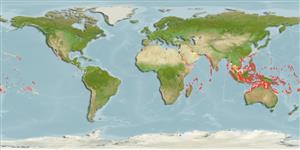>
Anguilliformes (Eels and morays) >
Congridae (Conger and garden eels) > Heterocongrinae
Etymology: Heteroconger: Greek, heteros = other + Latin, conger = conger (Ref. 45335).
Eponymy: Hans Hass (1919–2013) was an Austrian biologist, underwater cinematographer and scuba-diving pioneer. [...] (Ref. 128868), visit book page.
Environment: milieu / climate zone / rango de profundidad / distribution range
Ecología
marino asociado a arrecife; no migratorio; rango de profundidad 1 - 50 m (Ref. 90102). Tropical; 25°C - 29°C (Ref. 130583); 30°N - 23°S
Indo-Pacific: Red Sea and East Africa to the Society Islands, north to the Ryukyu and the Ogasawara islands, south to northwestern Australia and New Caledonia; throughout Micronesia (Ref. 1602).
Tamaño / Peso / Age
Madurez: Lm ? range ? - ? cm
Max length : 45.0 cm TL macho / no sexado; (Ref. 130583)
Espinas dorsales (total) : 0; Radios blandos dorsales (total) : 449 - 540; Espinas anales: 0; Radios blandos anales: 273 - 334; Vértebra: 163 - 177. Variable but usually two large black spots are obvious; body diameter to about 14 mm (Ref. 48635). Anterior nostrils included in continuous free labial flange. Pectoral fins minute. Total vertebrae 163-177, anal origin below vertebra 59-66.
Body shape (shape guide): eel-like; Cross section: circular.
Often found on sandy slopes below 15 m; withdraws into its burrow when approached. Usually in colonies containing up to several hundred individuals. Adults feed on zooplankton (Ref. 89972). Minimum depth reported taken from Ref. 86942.
Life cycle and mating behavior
Madurez | Reproducción | Puesta | Huevos | Fecundidad | Larva
Randall, J.E., G.R. Allen and R.C. Steene, 1990. Fishes of the Great Barrier Reef and Coral Sea. University of Hawaii Press, Honolulu, Hawaii. 506 p. (Ref. 2334)
IUCN Red List Status (Ref. 130435: Version 2025-1)
Threat to humans
Harmless
Human uses
Pesquerías: comercial; Acuario: Comercial
Herramientas
Special reports
Download XML
Fuentes de Internet
Estimates based on models
Preferred temperature (Referencia
123201): 25.4 - 29, mean 28 °C (based on 654 cells).
Phylogenetic diversity index (Referencia
82804): PD
50 = 0.5000 [Uniqueness, from 0.5 = low to 2.0 = high].
Bayesian length-weight: a=0.00102 (0.00046 - 0.00225), b=3.06 (2.88 - 3.24), in cm total length, based on all LWR estimates for this body shape (Ref.
93245).
Nivel trófico (Referencia
69278): 3.4 ±0.4 se; based on size and trophs of closest relatives
Resiliencia (Referencia
120179): Medio, población duplicada en un tiempo mínimo de 1.4-4.4 años (Preliminary K or Fecundity.).
Fishing Vulnerability (Ref.
59153): Low to moderate vulnerability (35 of 100).
🛈
Nutrients (Ref.
124155): Calcium = 60.3 [33.5, 97.1] mg/100g; Iron = 0.698 [0.420, 1.147] mg/100g; Protein = 18.2 [15.2, 21.2] %; Omega3 = 0.111 [0.051, 0.316] g/100g; Selenium = 38.9 [21.1, 80.8] μg/100g; VitaminA = 97.6 [27.9, 327.8] μg/100g; Zinc = 1.2 [0.8, 1.7] mg/100g (wet weight);
